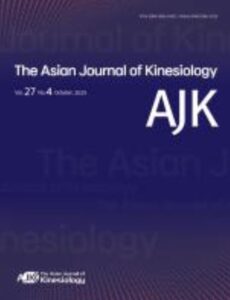Publications

Effects of Supine Scapular Punch Exercise Combined with the Maximum Abdominal Contraction Maneuver on Abdominal and Shoulder Stabilizer Muscle Activities and Upper Trapezius Muscle Tone
Authors: Ha-Yeon Bae 1, Chan-Mi Lee 2, Si-Hyeon Park 3, Seung-Ik Cho 4, Kyoung-Bin Min 5
Affiliations:
- Department of Sport Medicine, Korea University, Sejong Campus, Sejong, Republic of Korea
- Department of Sports Convergence, Korea University, Sejong Campus, Sejong, Republic of Korea
- Department of Sports Convergence, Korea University, Sejong Campus, Sejong, Republic of Korea
- Sports Medical Center, KonKuk University Medical Center, Seoul, Republic of Korea
- Department of Global Sport Studies, Korea University, Sejong Campus, Sejong, Republic of Korea
Journal: The Asian Journal of Kinesiology - October 2025, Volume 27, Issue 4, Pages 86-94 (DOI: 10.15758/ajk.2025.27.4.86)
-
Field & Applications:
- Medical
- Sport
- Treatment evaluation
- Recovery from injury
- Musculoskeletal rehabilitation
- Physiotherapy
- Musculoskeletal health
Purpose: This study investigated the effects of combining the maximum abdominal contraction maneuver (MACM) with supine scapular punching (SSP) on abdominal and shoulder stabilizer muscle activity and upper trapezius (UT) muscle tone in healthy adult men.
Methods: Twenty-one healthy men (aged 20-40 years) without shoulder dysfunction participated in a randomized crossover trial. The participants performed both SSP and SSP+MACM exercises in a randomized order. Surface electromyography was used to assess the muscle activity of the rectus abdominis (RA), external oblique (EO), internal oblique (IO), serratus anterior (SA), and UT. UT muscle tone was measured using MyotonPRO. Data were analyzed using paired t-tests or Wilcoxon signed-rank tests, and one-way repeated-measures ANOVA or Friedman tests based on data normality (α = 0.05).
Results: Compared with SSP alone, the SSP+MACM condition significantly increased the RA, EO, IO, and SA muscle activity (p < 0.05) and significantly reduced the UT activity (p < 0.05). Additionally, UT muscle tone was significantly decreased after SSP+MACM compared to both baseline and SSP (p < 0.001).
Conclusions: The combination of MACM and SSP effectively enhances abdominal and scapular stabilizer activation while reducing compensatory upper trapezius tension. This integrated approach may be a practical and efficient strategy for trunk and shoulder stabilization in rehabilitation and athletic training.

Figure 3. MyotonPRO probe location (a. Measurement location, b. MyotonPRO placement)
Keywords: maximum abdominal contraction, serratus anterior, supine scapular punch, trunk stability, upper trapezius
This study compared the effects of SSP and SSP+MACM on abdominal and shoulder stabilizer muscle activation and UT muscle tone in healthy adult men. The results revealed that SSP+MACM significantly increased the activation of the RA, EO, IO, and SA muscles while decreasing UT activation and muscle tone, thereby addressing the limitations of SSP alone in selectively activating the SA and suppressing UT compensation. These findings suggest that SSP+MACM is a practical exercise strategy that can simultaneously improve shoulder stability and reduce muscle tone within a short period. Further research is warranted to verify its applicability and long-term benefits in diverse populations and settings.


